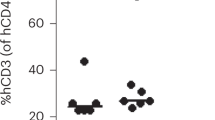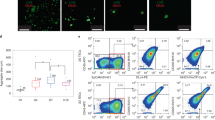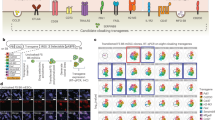Abstract
Small animal models with functional human lymphohematopoietic systems are highly valuable for the study of human immune function under physiological and pathological conditions. Over the last two decades, numerous efforts have been devoted towards the development of such humanized mouse models. This review is focused on human lymphohematopoietic reconstitution and immune function in humanized mice by cotransplantation of human fetal thymic tissue and CD34+ cells. The potential use of these humanized mice in translational biomedical research is also discussed.
This is a preview of subscription content, access via your institution
Access options
Subscribe to this journal
Receive 12 digital issues and online access to articles
$119.00 per year
only $9.92 per issue
Buy this article
- Purchase on Springer Link
- Instant access to full article PDF
Prices may be subject to local taxes which are calculated during checkout



Similar content being viewed by others
References
Shultz LD, Ishikawa F, Greiner DL . Humanized mice in translational biomedical research. Nat Rev Immunol 2007; 7: 118–130.
Traggiai E, Chicha L, Mazzucchelli L, Bronz L, Piffaretti JC, Lanzavecchia A et al. Development of a human adaptive immune system in cord blood cell-transplanted mice. Science 2004; 304: 104–107.
Ishikawa F, Yasukawa M, Lyons B, Yoshida S, Miyamoto T, Yoshimoto G et al. Development of functional human blood and immune systems in NOD/SCID/IL2 receptor γ chainnull mice. Blood 2005; 106: 1565–1573.
Ito M, Hiramatsu H, Kobayashi K, Suzue K, Kawahata M, Hioki K et al. NOD/SCID/γcnull mouse: an excellent recipient mouse model for engraftment of human cells. Blood 2002; 100: 3175–3182.
Shultz LD, Lyons BL, Burzenski LM, Gott B, Chen X, Chaleff S et al. Human lymphoid and myeloid cell development in NOD/LtSz-scid IL2R gamma null mice engrafted with mobilized human hemopoietic stem cells. J Immunol 2005; 174: 6477–6489.
Shultz LD, Saito Y, Najima Y, Tanaka S, Ochi T, Tomizawa M et al. Generation of functional human T-cell subsets with HLA-restricted immune responses in HLA class I expressing NOD/SCID/IL2rγnull humanized mice. Proc Natl Acad Sci USA 2010; 107: 13022–13027.
Jaiswal S, Pearson T, Friberg H, Shultz LD, Greiner DL, Rothman AL et al. Dengue virus infection and virus-specific HLA-A2 restricted immune responses in humanized NOD-scid IL2rγnull mice. PLoS ONE 2009; 4: e7251.
Strowig T, Gurer C, Ploss A, Liu YF, Arrey F, Sashihara J et al. Priming of protective T cell responses against virus-induced tumors in mice with human immune system components. J Exp Med 2009; 206: 1423–1434.
Watanabe Y, Takahashi T, Okajima A, Shiokawa M, Ishii N, Katano I et al. The analysis of the functions of human B and T cells in humanized NOD/shi-scid/γcnull (NOG) mice (hu-HSC NOG mice). Int Immunol 2009; 21: 843–858.
Danner R, Chaudhari SN, Rosenberger J, Surls J, Richie TL, Brumeanu TD et al. Expression of HLA class II molecules in humanized NOD.Rag1KO.IL2RgcKO mice is critical for development and function of human T and B cells. PLoS ONE 2011; 6: e19826.
Itoh M, Takahashi T, Sakaguchi N, Kuniyasu Y, Shimizu J, Otsuka F et al. Thymus and autoimmunity: production of CD25+CD4+ naturally anergic and suppressive T cells as a key function of the thymus in maintaining immunologic self-tolerance. J Immunol 1999; 162: 5317–5326.
Watanabe N, Wang YH, Lee HK, Ito T, Wang YH, Cao W et al. Hassall's corpuscles instruct dendritic cells to induce CD4+CD25+ regulatory T cells in human thymus. Nature 2005; 436: 1181–1185.
Jiang Q, Zhang L, Wang R, Jeffrey J, Washburn ML, Brouwer D et al. FoxP3+CD4+ regulatory T cells play an important role in acute HIV-1 infection in humanized Rag2−/−γC−/− mice in vivo. Blood 2008; 112: 2858–2868.
Soumelis V, Reche PA, Kanzler H, Yuan W, Edward G, Homey B et al. Human epithelial cells trigger dendritic cell mediated allergic inflammation by producing TSLP. Nat Immunol 2002; 3: 673–680.
Reche PA, Soumelis V, Gorman DM, Clifford T, Liu M, Travis M et al. Human thymic stromal lymphopoietin preferentially stimulates myeloid cells. J Immunol 2001; 167: 336–343.
Namikawa R, Weilbaecher KN, Kaneshima H, Yee EJ, McCune JM . Long-term human hematopoiesis in the SCID-hu mouse. J Exp Med 1990; 172: 1055–1063.
McCune JM, Namikawa R, Kaneshima H, Shultz LD, Lieberman M, Weissman IL . The SCID-hu mouse: murine model for the analysis of human hematolymphoid differentiation and function. Science 1988; 241: 1632–1639.
Namikawa R, Kaneshima H, Lieberman M, Weissman IL, McCune JM . Infection of the SCID-hu mouse by HIV-1. Science 1988; 242: 1684–1686.
Lan P, Wang L, Diouf B, Eguchi H, Su H, Bronson R et al. Induction of human T-cell tolerance to porcine xenoantigens through mixed hematopoietic chimerism. Blood 2004; 103: 3964–3969.
Lan P, Tonomura N, Shimizu A, Wang S, Yang YG . Reconstitution of a functional human immune system in immunodeficient mice through combined human fetal thymus/liver and CD34+ cell transplantation. Blood 2006; 108: 487–492.
Shultz LD, Schweitzer PA, Christianson SW, Gott B, Schweitzer IB, Tennent B et al. Multiple defects in innate and adaptive immunologic function in NOD/LtSz-scid mice. J Immunol 1995; 154: 180–191.
Hesselton RM, Greiner DL, Mordes JP, Rajan TV, Sullivan JL, Shultz LD . High levels of human peripheral blood mononuclear cell engraftment and enhanced susceptibility to human immunodeficiency virus type 1 infection in NOD/LtSz-scid/scid mice. J Infect Dis 1995; 172: 974–982.
Pflumio F, Izac B, Katz A, Shultz LD, Vainchenker W, Coulombel L . Phenotype and function of human hematopoietic cells engrafting immune-deficient CB17-severe combined immunodeficiency mice and nonobese diabetic-severe combined immunodeficiency mice after transplantation of human cord blood mononuclear cells. Blood 1996; 88: 3731–3740.
Stefanova I, Dorfman JR, Germain RN . Self-recognition promotes the foreign antigen sensitivity of naive T lymphocytes. Nature 2002; 420: 429–434.
McLellan AD, Kampgen E . Functions of myeloid and lymphoid dendritic cells. Immunol Lett 2000; 72: 101–105.
Liu YJ . Dendritic cell subsets and lineages, and their functions in innate and adaptive immunity. Cell 2001; 106: 259–262.
Tonomura N, Habiro K, Shimizu A, Sykes M, Yang YG . Antigen-specific human T-cell responses and T cell-dependent production of human antibodies in a humanized mouse model. Blood 2008; 111: 4293–4296.
Melkus MW, Estes JD, Padgett-Thomas A, Gatlin J, Denton PW, Othieno FA et al. Humanized mice mount specific adaptive and innate immune responses to EBV and TSST-1. Nat Med 2006; 12: 1316–1322.
Manz MG, Di Santo JP . Renaissance for mouse models of human hematopoiesis and immunobiology. Nat Immunol 2009; 10: 1039–1042.
Sugamura K, Asao H, Kondo M, Tanaka N, Ishii N, Ohbo K et al. The interleukin-2 receptor gamma chain: its role in the multiple cytokine receptor complexes and T cell development in XSCID. Annu Rev Immunol 1996; 14: 179–205.
Onoe T, Kalscheuer H, Chittenden M, Zhao G, Yang YG, Sykes M . Homeostatic expansion and phenotypic conversion of human T cells depend on peripheral interactions with APCs. J Immunol 2010; 184: 6756–6765.
Tonomura N, Shimizu A, Wang S, Yamada K, Tchipashvili V, Weir GC et al. Pig islet xenograft rejection in a mouse model with an established human immune system. Xenotransplantation 2008; 15: 129–135.
Habiro K, Sykes M, Yang YG . Induction of human T-cell tolerance to pig xenoantigens via thymus transplantation in mice with an established human immune system. Am J Transplant 2009; 9: 1324–1329.
Brainard DM, Seung E, Frahm N, Cariappa A, Bailey CC, Hart WK et al. Induction of robust cellular and humoral virus-specific adaptive immune responses in human immunodeficiency virus-infected humanized BLT mice. J Virol 2009; 83: 7305–7321.
Onoe T, Kalscheuer H, Danzl N, Chittenden M, Zhao G, Yang YG et al. Human natural regulatory T cell development, suppressive function, and postthymic maturation in a humanized mouse model. J Immunol 2011; 187: 3895–3903.
Duan K, Zhang B, Zhang W, Zhao Y, Qu Y, Sun C et al. Efficient peripheral construction of functional human regulatory CD4+CD25highFoxp3+ T cells in NOD/SCID mice grafted with fetal human thymus/liver tissues and CD34+ cells. Transpl Immunol 2011; 25: 173–179.
Thornton AM, Korty PE, Tran DQ, Wohlfert EA, Murray PE, Belkaid Y et al. Expression of Helios, an Ikaros transcription factor family member, differentiates thymic-derived from peripherally induced Foxp3+ T regulatory cells. J Immunol 2010; 184: 3433–3441.
McClymont SA, Putnam AL, Lee MR, Esensten JH, Liu W, Hulme MA et al. Plasticity of human regulatory T cells in healthy subjects and patients with type 1 diabetes. J Immunol 2011; 186: 3918–3926.
Greiner DL, Hesselton RA, Shultz LD . SCID mouse models of human stem cell engraftment. Stem Cells 1998; 16: 166–177.
Gapin L . iNKT cell autoreactivity: what is ‘self’ and how is it recognized? Nat Rev Immunol 2010; 10: 272–277.
Kronenberg M . Toward an understanding of NKT cell biology: progress and paradoxes. Annu Rev Immunol 2005; 23: 877–900.
Brigl M, Brenner MB . CD1: antigen presentation and T cell function. Annu Rev Immunol 2004; 22: 817–890.
Lockridge JL, Chen X, Zhou Y, Rajesh D, Roenneburg DA, Hegde S et al. Analysis of the CD1 antigen presenting system in humanized SCID mice. PLoS ONE 2011; 6: e21701.
Mrozek E, Anderson P, Caligiuri MA . Role of interleukin-15 in the development of human CD56+ natural killer cells from CD34+ hematopoietic progenitor cells. Blood 1996; 87: 2632–2640.
Rosenzwajg M, Canque B, Gluckman JC . Human dendritic cell differentiation pathway from CD34+ hematopoietic precursor cells. Blood 1996; 87: 535–544.
Stec M, Weglarczyk K, Baran J, Zuba E, Mytar B, Pryjma J et al. Expansion and differentiation of CD14+CD16− and CD14++CD16+ human monocyte subsets from cord blood CD34+ hematopoietic progenitors. J Leukoc Biol 2007; 82: 594–602.
Leary AG, Yang YC, Clark SC, Gasson JC, Golde DW, Ogawa M . Recombinant gibbon interleukin 3 supports formation of human multilineage colonies and blast cell colonies in culture: comparison with recombinant human granulocyte-macrophage colony-stimulating factor. Blood 1987; 70: 1343–1348.
Giarratana MC, Kobari L, Lapillonne H, Chalmers D, Kiger L, Cynober T et al. Ex vivo generation of fully mature human red blood cells from hematopoietic stem cells. Nat Biotechnol 2005; 23: 69–74.
Eisenman J, Ahdieh M, Beers C, Brasel K, Kennedy MK, Le T et al. Interleukin-15 interactions with interleukin-15 receptor complexes: characterization and species specificity. Cytokine 2002; 20: 121–129.
Metcalf D . The molecular biology and functions of the granulocyte-macrophage colony-stimulating factors. Blood 1986; 67: 257–267.
Mosmann TR, Yokota T, Kastelein R, Zurawski SM, Arai N, Takebe Y . Species-specificity of T cell stimulating activities of IL 2 and BSF-1 (IL 4): comparison of normal and recombinant, mouse and human IL 2 and BSF-1 (IL 4). J Immunol 1987; 138: 1813–1816.
Fixe P, Praloran V . Macrophage colony-stimulating-factor (M-CSF or CSF-1) and its receptor: structure–function relationships. Eur Cytokine Netw 1997; 8: 125–136.
Stevenson LM, Jones DG . Cross-reactivity amongst recombinant haematopoietic cytokines from different species for sheep bone-marrow eosinophils. J Comp Pathol 1994; 111: 99–106.
Huntington ND, Legrand N, Alves NL, Jaron B, Weijer K, Plet A et al. IL-15 trans-presentation promotes human NK cell development and differentiation in vivo. J Exp Med 2009; 206: 25–34.
Chen Q, Khoury M, Chen J . Expression of human cytokines dramatically improves reconstitution of specific human-blood lineage cells in humanized mice. Proc Natl Acad Sci USA 2009; 106: 21783–21788.
Willinger T, Rongvaux A, Strowig T, Manz MG, Flavell RA . Improving human hemato-lymphoid-system mice by cytokine knock-in gene replacement. Trends Immunol 2011; 32: 321–327.
Willinger T, Rongvaux A, Takizawa H, Yancopoulos GD, Valenzuela DM, Murphy AJ et al. Human IL-3/GM-CSF knock-in mice support human alveolar macrophage development and human immune responses in the lung. Proc Natl Acad Sci USA 2011; 108: 2390–2395.
Rathinam C, Poueymirou WT, Rojas J, Murphy AJ, Valenzuela DM, Yancopoulos GD et al. Efficient differentiation and function of human macrophages in humanized CSF-1 mice. Blood 2011; 118: 3119–3128.
Rongvaux A, Willinger T, Takizawa H, Rathinam C, Auerbach W, Murphy AJ et al. Human thrombopoietin knockin mice efficiently support human hematopoiesis in vivo. Proc Natl Acad Sci USA 2011; 108: 2378–2383.
Hu Z, Van Rooijen N, Yang YG . Macrophages prevent human red blood cell reconstitution in immunodeficient mice. Blood 2011; 118: 5719–5720.
Wang H, VerHalen J, Madariaga ML, Xiang S, Wang S, Lan P et al. Attenuation of phagocytosis of xenogeneic cells by manipulating CD47. Blood 2007; 109: 836–842.
Wang H, Madariaga ML, Wang S, van Rooijen N, Oldenborg PA, Yang YG . Lack of CD47 on nonhematopoietic cells induces split macrophage tolerance to CD47null cells. Proc Natl Acad Sci USA 2007; 104: 13744–13749.
Ide K, Wang H, Tahara H, Liu J, Wang X, Asahara T et al. Role for CD47–SIRPalpha signaling in xenograft rejection by macrophages. Proc Natl Acad Sci USA 2007; 104: 5062–5066.
Takenaka K, Prasolava TK, Wang JC, Mortin-Toth SM, Khalouei S, Gan OI et al. Polymorphism in Sirpa modulates engraftment of human hematopoietic stem cells. Nat Immunol 2007; 8: 1313–1323.
Acknowledgements
The authors thank Dr Goda Choi for critical reading of the manuscript. We apologize to those investigators whose work could not be cited as a result of space limitations. The work from the authors' laboratory discussed in this review was supported by grants from NIH (RC1 HL100117, R01 AI064569, PO1 CA111519 and PO1 AI045897) and JDRF (1-2005-72).
Author information
Authors and Affiliations
Corresponding author
Rights and permissions
About this article
Cite this article
Hu, Z., Yang, YG. Human lymphohematopoietic reconstitution and immune function in immunodeficient mice receiving cotransplantation of human thymic tissue and CD34+ cells. Cell Mol Immunol 9, 232–236 (2012). https://doi.org/10.1038/cmi.2011.63
Received:
Accepted:
Published:
Issue Date:
DOI: https://doi.org/10.1038/cmi.2011.63
Keywords
This article is cited by
-
Monitoring Immune Cell Function Through Optical Imaging: a Review Highlighting Transgenic Mouse Models
Molecular Imaging and Biology (2022)



